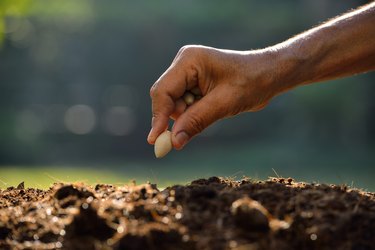
Beans (Phaseolus vulgaris) are easy-to-grow annual vegetables. While you can speed germination of many seeds by soaking in water overnight, don't soak beans before planting. Bean seeds lack the hard outer shells that need pretreatment to speed sprouting. Soaking bean seeds generally results in poor germination; instead, plant in warm, moist soil for best results in the garden.
About the Beans
Video of the Day
Native to Mexico and Central America, bean cultivars vary by growth pattern and the pod color. Pole beans are space-saving choices, as the vines grow up to 8 feet tall on a trellis. You can grow pole beans up a wall, over a fence or on a "teepee." 'Kentucky Wonder' is an heirloom cultivar that produces 8-inch-long pods while 'Kentucky Wonder Wax' produces yellow, and 'Purple Pole' features purple pods.
Video of the Day
Bush beans have short, bushy vines that grow 24 inches tall. Spacing the beans closely provides sufficient support for the vines. 'Blue Lake Bush' and 'Tendercrop' are among the many bush cultivars. In general, bush beans are ready to harvest 50 to 60 days after planting, while pole beans are ready between 60 and 100 days, depending on the cultivar.
An unusual relative of the traditional green bean, enjoyed for its red-flowering vines as well as in tasty bean dishes, is 'Scarlet Runner' (Phaseolus coccineus), hardy in U.S. Department of Agriculture plant hardiness zones 7 through 11. The vines die back at frost and regrow in spring from the tuberous roots.
Plant the Beans

Select a warm sunny location for your beans. Put on gloves, safety goggles and a dust mask, then dig in 2 to 4 inches of well-decomposed compost to lighten the soil and add organic matter. When soil temperatures reach 60 to 85 degrees, moisten the garden bed.
Plant bush beans 2 to 4 inches apart and pole beans 4 to 6 inches apart, with the rows 18 to 24 inches apart and 30 to 36 inches apart, respectively. Install support structures, such as trellises and poles, at planting time. Keep the soil evenly moist, but not waterlogged. The beans should germinate in four to 10 days.
When seedlings reach 4 to 6 inches tall, sterilize scissors in rubbing alcohol and snip off the weakest seedlings. Bush beans should be spaced at 6 inches and pole beans at 6 to 12 inches.
Care and Feeding of Beans
Use soaker hoses or hose-end bubblers when watering to avoid wetting the foliage. Add a layer of mulch to help reduce evaporation from the soil. Pull weeds as soon as they appear and snip off the stems of larger weeds to avoid disturbing the beans' roots.
Fertilize by adding a few shovelfuls of compost midseason, approximately 30 days after planting. Avoid nitrogen-rich fertilizers; beans fix their own nitrogen, and adding more to the soil will result in foliage instead of flowers and beans. You can also apply diluted fish emulsion or compost tea every week or two. Water thoroughly after fertilizing.
Harvest the beans when the pod is plump and crisp but before the beans grow too large. If you miss a few pods, allow the beans to ripen and dry, then shuck and finish drying for use as dried beans in soups. Store freshly picked beans in the refrigerator for up to three days. Wash before cooking, preparing for the freezer or pressure canning.
Soak Beans Before Planting
The only time you should soak bean seeds is when germinating mung beans (Vigna radiata) for their tender young sprouts. Sanitizing the seeds helps avoid bacterial contamination of sprouts.

Heat 3 percent hydrogen peroxide to 140 degrees Fahrenheit. Put the beans in a mesh strainer and dip into the heated solution for five minutes. Swirl every minute, then rinse under running water for one minute. Place in a bowl, cover with water and skim off any floating debris.
Place the seeds in sterile sprouting containers and cover with lukewarm water at a 1 to 4 ratio. Let stand overnight, pour off the water and rinse the seeds thoroughly. Repeat every four hours for three to four days, until the sprouts are 1 to 2 inches long and ready to eat.
- Harvest to Table: How to Grow Beans
- Harvest to Table: Beans Seed Starting Tips
- University of Illinois Extension - Watch Your Garden Grow: Beans
- Wisconsin Horticulture Division of Extension: Scarlet Runner Bean, Phaseolus Coccineus
- Kansas State Research and Extension / University of Missouri Extension: Sprouting Seeds at Home - Safely
- National Gardening Association: Mr. Green Beans